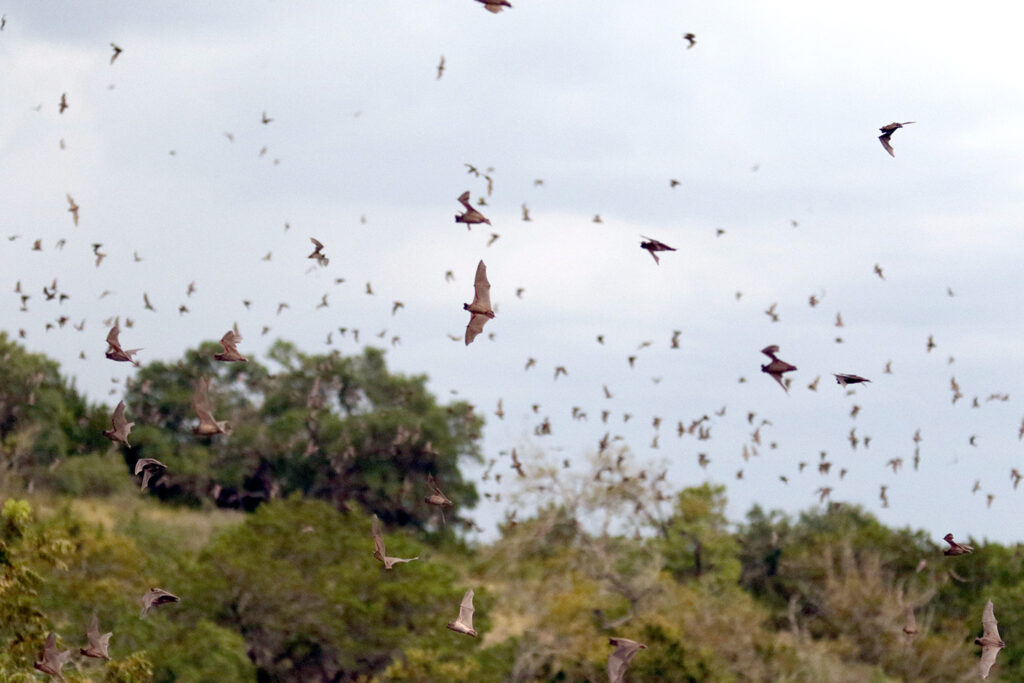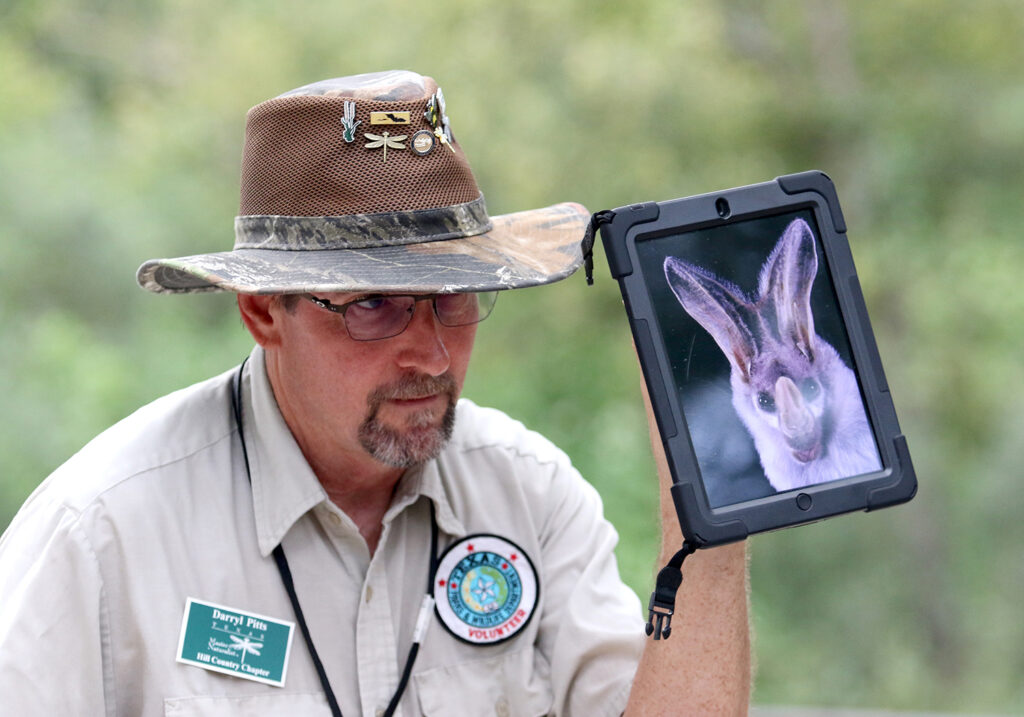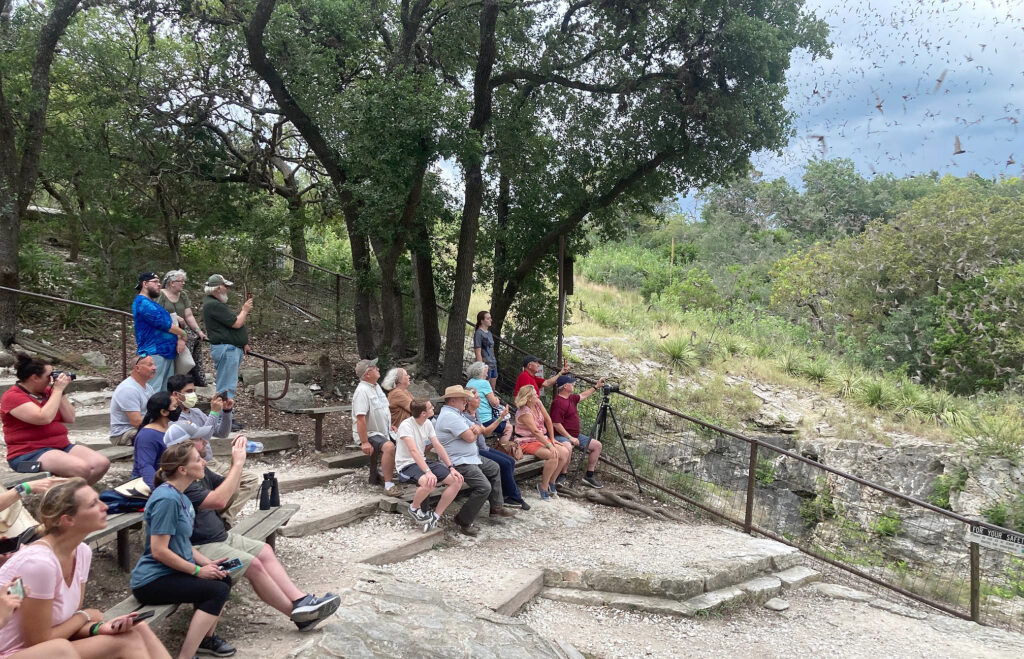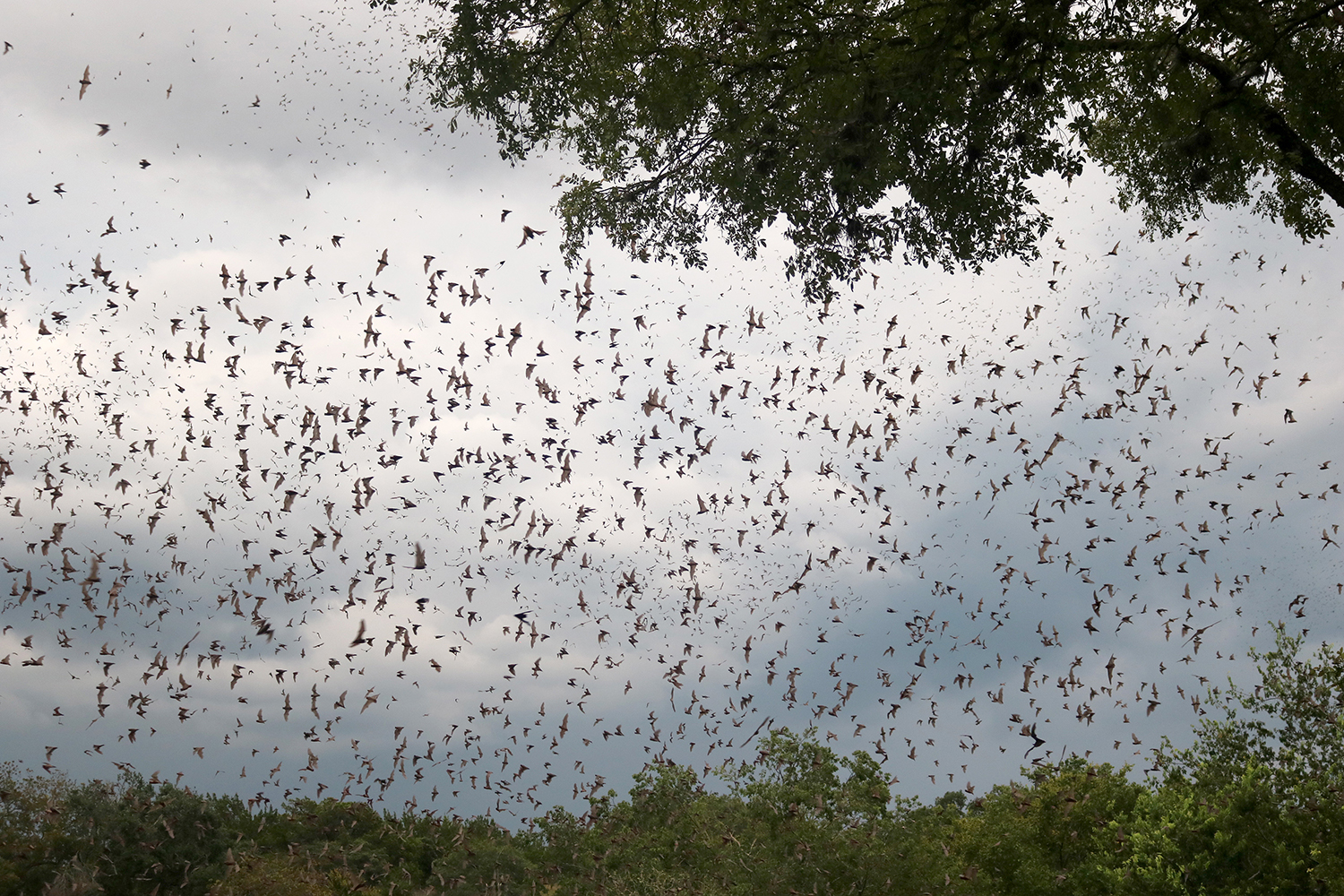The moon is half full. We sit on benches, facing the 100-foot-wide opening to the cactus-lined cave. There are bird songs, different from the city bird songs, along with cicadas and a cricket chorus. Visitors sit patiently, not so much on their phones as they are readying their phones to record the show. It is a Wednesday night at Bracken Cave Preserve, and the bats are about to emerge.
Bracken Cave, located next door to Natural Bridge Caverns, holds the largest bat colony in the world — between 15 and 20 million Mexican free-tailed bats. That’s 500 bats per square foot. It’s a maternity roost, says Bracken director Fran Hutchins, full of bat mothers, each giving birth to only one bat pup. The babies are born in mid-June.

“It’s a giant incubator, 104 degrees. Babies don’t need to spend energy keeping warm. They can just focus on growing,” he said. “It’s the perfect habitat: very hot, very humid, very safe.”
Hutchins got into bats through his hobby: caving. “I kept crawling in caves, bumping into bats, so I started volunteering for BCI,” he said.
BCI is Bat Conservation International, headquartered in Austin, which owns Bracken Cave. Originally, only 4.7 acres were protected. Thanks to BCI, The Nature Conservancy, and partnerships between local governments and donors, there are now almost 6,000 acres of protected green space, shielding a habitat of the endangered golden-cheeked warbler and a recharge zone for the Edwards Aquifer.
The preserve also protects the bats, which protect us from insects by consuming over 150 tons of bugs each night. “That’s, like, 200,000 Whataburgers,” Hutchins said.

From the cave the bats travel southeast toward Poteet and Jourdanton, where they eat agricultural pests. The bats live in Hill Country caves from mid-February to around Thanksgiving, depending on the weather. The best viewing is during the warm months, and the emergence is at its peak after the babies are full grown, in late July and early August.
“The surprise for people visiting is so many animals in one place, at one time, completely ignoring us,” Hutchins said. “The bats are 20 feet away. They create a vortex, a ‘bat-nado.’ You hear them, feel them, smell them. Hawks come down and catch dinner. Foxes and snakes in front of the opening catch dinner.”
Even up close to so many wild animals, the viewers of this spectacle are quiet. “That’s not unusual, and we ask that everyone be as quiet as possible,” Hutchins said.
Texas is home to 32 species of bats, more than any other state. BCI volunteer Steph Dodson says one species, the Mexican long-nose bat, plays a key role in that beloved summer cocktail, the margarita. Long-nosed bats act as pollinators for the agave plant, from which we get tequila.
“I say, if you like a margarita, say, Thank you, bats!” Dodson said. “Tell your waitress! Tell your bartender!”
She also encourages visitors to drive slowly down the gravel road to the cave and keep an eye out for “ringtails, foxes, and roadrunners.”

The Texas Hill Country, full of limestone caves, is grand central for bat viewing. A detailed list, created in partnership with BCI, can be found at the Texas Parks and Wildlife website, under Bats. Choose any location you think you’ll like and check it out from May to October. tpwd.texas.gov
The emergence at Bracken Cave begins around sunset — slowly at first, until the bats become a swirling vortex. They make an S curve, then veer away continuously for more than 30 minutes. There is a flapping sound, like rain. No silly screeching, just wings. A smell, but not a stench. The mosquitoes, so bothersome a minute before, suddenly gone. The charcoal river of flying mammals scours the sky.
We leave in silence, in awe.
Bracken Cave Preserve. Near New Braunfels. 15-20 million bats. Reservations required. Cost: $32.55, with tickets available through Natural Bridge Caverns and Bat Conservation International.
Bamberger Ranch Preserve. Johnson City. 1 million bats in a man-made cave on a private ranch. Reservations required. Cost: $10 per person or $15 for group tours.
Congress Avenue Bridge. Austin. 1.5 million bats. No reservations. Cost: free, but paid cruises are available, and tickets are sold for Bat Fest in September.
Camden Street Bridge. San Antonio. 500,000 bats. No reservations. Cost: free.
Devil’s Sinkhole State Natural Area. Rocksprings. 3 million bats. Wednesday-Sunday evenings. Cost: adults $14, seniors $11, children 4-12 $6, children under 4 free.
Ekert James River Bat Cave Preserve. Between Mason and Harper. 4-6 million bats. Thursday-Sunday evenings. Cost: $5 per person, children under 5 free.
Frio Bat Cave. Near Concan. 10 million bats. Reservations required. Cost: adults $15, military/veteran/first responder/seniors $12, children 6-10 $12, children 5 and under free.
Old Tunnel. Fredericksburg. 3 million bats. Reservations required. Cost: $5 per person. No children under 4 allowed in the lower deck area.


